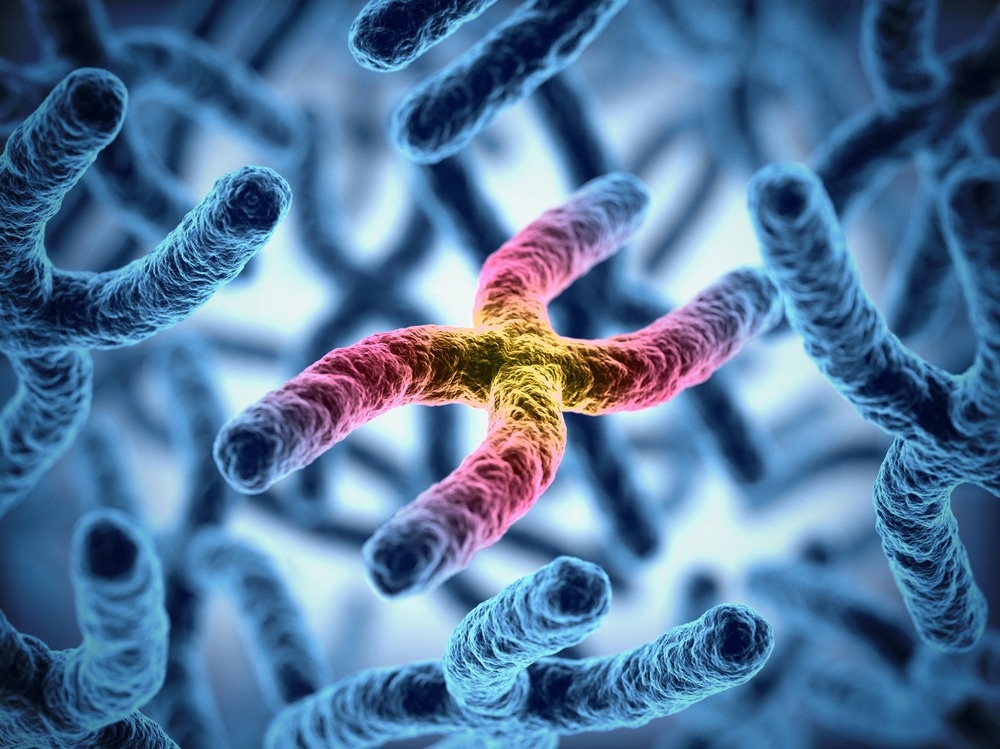Genetic disorders are caused due to the presence of errors in the DNA sequence compared to regular genomic sequences. These disorders are caused by a mutation in a single gene (monogenic) or several genes (polygenic). Polygenic disorders could also be caused by a combinational effect of gene mutations and environmental factors or by damage to chromosomes.

Image Credit: koya979/Shutterstock.com
Scientists have been working extensively to understand monogenic and polygenic human diseases. Some monogenic traits (product of a single gene) are cleft chin and face freckles, whereas polygenic traits are the color of eyes and height of a person (product of multiple genes).
The study of the human genome sequence has helped incredibly to understand the widespread markers of genetic variation. It has also helped scientists develop new technologies to determine disease phenotypes with genetic loci. Although polygenic diseases are more common than monogenic diseases, studies of single-gene disorders provide invaluable information about the underlying molecular mechanisms that help understand all forms of genetic diseases.
Monogenic Diseases
The human genome is comprised of around 20,000-25,000 genes that are the backbone of all proteins synthesized. In monogenic diseases, only one of these genes is mutated. Some examples of monogenic diseases are Cystic fibrosis, Sickle cell anemia, Haemophilia, Tay-Sachs disease, and Huntington’s disease. These diseases are rare, more severe, and affect fewer people than polygenic diseases.
Scientists have identified over 4000 genetic diseases caused by a mutation in a single gene. In the USA, approximately 30 million people and globally, 300 million people are affected by different monogenic diseases. Many monogenic diseases are heritable, i.e., passed on from parents to children. A child inherits two copies of each gene from their parents, one from their mother and one from their father. Different combinations of these genes determine if the child will develop a particular disease.
Monogenic diseases can be dominant or recessive and autosomal or sex-linked. For instance, in the case of autosomal dominant inheritance, one copy of the faulty gene from either of the parents can cause the disease. In the case of autosomal recessive inheritance, two copies of faulty genes, one from each parent, are essential to cause the disease. Another method of monogenic disease inheritance is X-linked inheritance, where the faulty gene is only present in the X-chromosome (female chromosome). Irrespective of the method of inheritance, these diseases are easier to detect compared to polygenic diseases.
One of the common monogenic diseases in the European royal family is Hemophilia A. Scientists revealed that this disease occurred due to a sudden mutation in the F8 gene, located on the X-chromosome. The product of this gene is called Factor VIII, which is involved with blood clotting after a wound. Without Factor VIII, blood clotting does not occur, leading to excessive bleeding.
Polygenic Diseases
Various factors influence polygenic or non-Mendelian traits. As stated above, two of the most common polygenic traits are human height and eye color. In the case of human height, researchers found that hundreds of genes are involved in the presentation of this trait. This particular trait also depends on various other factors, such as nutrition.
Polygenic diseases are multifactorial and are more prevalent compared to monogenic diseases. These diseases occur due to various factors, such as genetic variations and environmental factors (e.g., nutrition, exercise, and environmental exposures). Scientists revealed that polygenic diseases, such as type 2 diabetes, coronary artery disease, Alzheimer’s disease, cancer, and schizophrenia, are typically diagnosed in the adult years. This is because of complex assessment processes.
Polygenetic diseases, such as heart disease, arthritis, Type 2 diabetes, and many neurodegenerative diseases, are caused by mutations in several genes, and the contribution of each gene is different. The cumulative effect of gene mutations results in polygenic diseases. Other factors, such as age, sex, nutrition, etc., also play a definitive role in the manifestation of these diseases.
For instance, type 2 diabetes is a disease that is characterized by the presence of a high level of glucose circulating in the blood, and some of the common symptoms of this disease are polyphagia, polyuria, and polydipsia. More than 36 genes (e.g., TCF7L2 allele) are associated with the risk of developing diabetes. Some of these genes are also linked to beta cell functions. Other non-genetic factors also linked with the contraction of diabetes include lifestyle and diet.

Image Credit: Csaba Deli/Shutterstock.com
Screening for Monogenic and Polygenic Diseases
Individuals who are carriers of monogenic diseases can be determined via carrier screening methods. Even when individuals do not express a monogenic disease, they can be carriers of a faulty gene and pass it on to their children. Some of the methods involved in detecting monogenic diseases are polymerase chain reaction, Southern analysis, allele-specific oligonucleotide screening, linkage analysis, and automated DNA nucleotide sequencing.
In the case of the determination of polygenic diseases, the advancements in genomics and DNA databases have enormously helped clinicians calculate a polygenic risk score. This score estimates an individual’s risks of developing a complex disease based on their unique genetic variations. Genome-wide association studies (GWAS) are typically used to detect these disorders. Researchers detect genes involved in the development of polygenic diseases predominantly by two strategies, i.e., identifying specific genes that produce protein products associated with the etiopathogenesis of the disease, and sequencing the entire genome using the panel of genetic markers that are almost uniformly distributed across the genome.
Sources:
- Hombalkar, S. (2022) What Are Monogenic And Polygenic Traits? [Online] Available at: https://www.scienceabc.com/humans/what-are-monogenic-and-polygenic-traits.html
- Trinder, M. et al. (2020). Association of Monogenic vs Polygenic Hypercholesterolemia with Risk of Atherosclerotic Cardiovascular Disease. JAMA cardiology, 5(4). pp. 390–399. https://doi.org/10.1001/jamacardio.2019.5954
- Arielle Strasser. (2021) What is the difference between monogenic and polygenic diseases? [Online] Available at: https://guides.orchidhealth.com/post/monogenic-vs-polygenic-diseases#:~:text=On%20one%20end%20of%20the,combined%20effects%20of%20many%20genes
- Rimbert, A. et al. (2021) Phenotypic Differences Between Polygenic and Monogenic Hypobetalipoproteinemia. Arteriosclerosis, Thrombosis, and Vascular Biology. 41:e63–e71. https://doi.org/10.1161/ATVBAHA.120.315491
- Chial, H. (2008) Rare Genetic Disorders: Learning About Genetic Disease Through Gene Mapping, SNPs, and Microarray Data. Nature Education. 1(1).192.
Further Reading
Last Updated: Jun 27, 2022